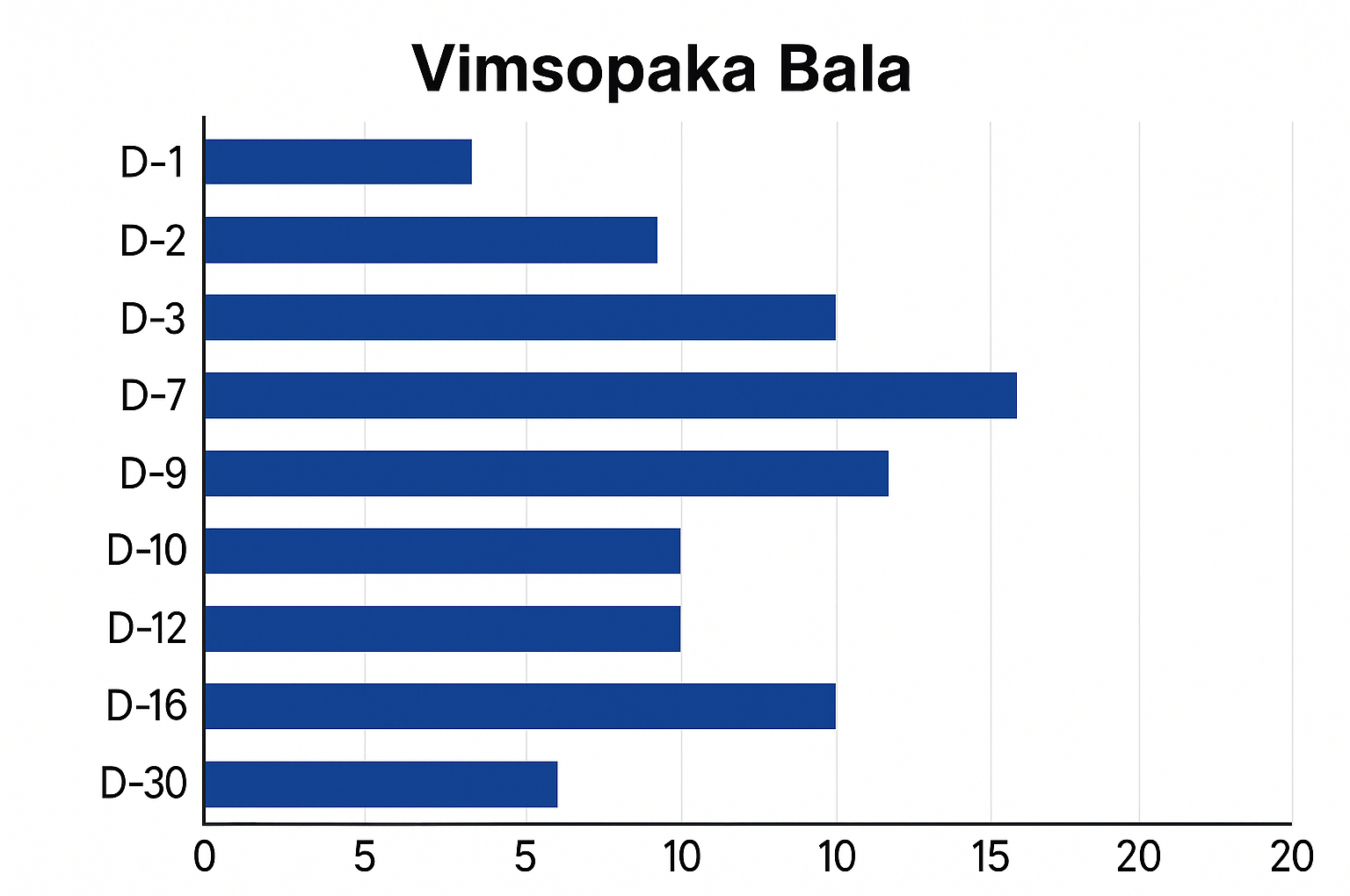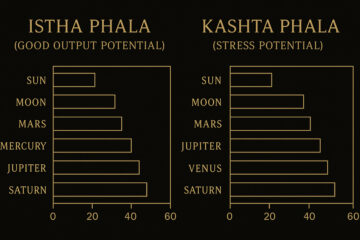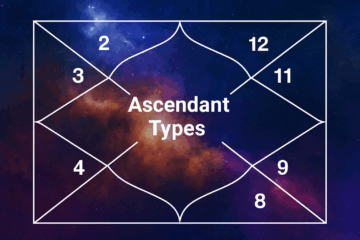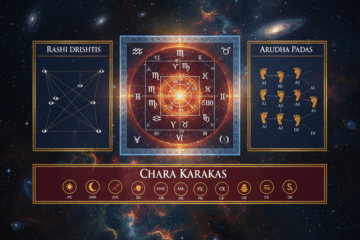When a Mahadasha hits, everyone asks the same question: “Will this period feel good for me or not?” But in real Jyotish, “good” is not only events, money, career spikes, or marriage timing. It is also: Do I feel aligned? Settled? Supported? At peace with how life is unfolding? Vimsopaka Bala in Vedic astrology was given by Parashara exactly for that layer of judgment.
It measures how harmoniously a planet behaves across multiple divisional charts (Vargas), and it assigns a weighted score. The result is like a planetary report card: not just how loud the planet is, but how gracefully it functions in the important areas of life.
The principle is elegant. Each divisional chart speaks for a part of life — self, resources, siblings/initiative, marriage/dharma, parents/lineage, misfortune/struggle. Vimsopaka Bala asks: does this planet behave with dignity in each of those rooms? If yes, that planet can give balanced, internally satisfying results in its Mahadasha and Antardasha. If no, it may still “do things,” but the person can feel restless, incomplete, or emotionally unsatisfied while those things are happening.
This is why serious astrologers rely on Vimsopaka Bala in Vedic astrology when they want to understand not just outcomes, but the felt quality of those outcomes. Two people can both get promoted. Only one of them will sleep well at night.
The Classical Parashari Scheme for Vimsopaka Bala
Maharshi Parashara outlined a six-Varga model where each divisional chart contributes a certain number of points toward a planet’s total strength. The weights are not equal; certain Vargas matter more for overall life flow.
- Rasi (D1) – 6 points
- Hora (D2) – 2 points
- Drekkana (D3) – 4 points
- Navamsa (D9) – 5 points
- Dwadasamsa (D12) – 2 points
- Trimsamsa (D30) – 1 point
Total = 20 possible points. This twenty-point ceiling is the reference. A planet’s Vimsopaka Bala in Vedic astrology is basically the weighted sum of how well that planet is placed across these six Vargas.
Notice what’s in the list. D1 (Rasi) is obvious: core life, identity, body, fundamental narrative. D9 (Navamsa) is also obvious: dharma, marriage, integrity, “inner contract.” D3 (Drekkana) tracks vitality, initiative, courage, siblings/support network. D12 (Dwadasamsa) reflects parental lineage and inherited patterns. D30 (Trimsamsa) is linked to misfortune, flaws, and karmic friction. D2 (Hora) is classically tied to resources and sustenance.
So together, Parashara is basically saying: if a planet behaves with dignity and friendliness across self, support, dharma, lineage, survival pressure, and basic resources, that planet can deliver a life chapter that feels integrated, not fragmented.
How Dignity Is Converted Into Score
Vimsopaka Bala is not just “exalted or fallen.” In fact, exaltation and debilitation are not the main obsession here. The focus is on qualitative dignity and relational comfort. We ask: Is the planet in its Mooltrikona? Own sign? A friendly sign? At least neutral? Or is it stuck with enemies?
A common dignity scale used in practice is:
- Mooltrikona: ~100%
- Own Sign: ~90%
- Fast Friend / Strong Friendliness: ~80–90%
- Friend: ~75%
- Neutral: ~60%
- Enemy: ~50%
- Great Enemy: ~35%
Here is how you actually apply it. Suppose Mars is:
- In its Mooltrikona in D1 (Rasi) → treat as ~100% of that chart’s weight (6 points)
- In a friendly sign in D9 (Navamsa) → you might take ~80–90% of that chart’s weight (5 points)
- In a neutral sign in D3 (Drekkana) → you might take ~60% of that chart’s weight (4 points)
You repeat this process across all six Vargas, multiply the dignity percentage by the Varga’s assigned weight, then sum. At the end you get a score out of 20. That final number is the Vimsopaka Bala in Vedic astrology for that planet.
Interpretation guideline that many practitioners use in live readings:
- 10 or more (out of 20): The planet tends to deliver its Mahadasha results in a way that feels balanced, meaningful, and not wildly disruptive. It might still challenge you, but you’ll usually say “I needed that,” not “why is this happening to me.”
- Below 10: The planet may create results that look active on the surface but feel incomplete, unstable, or emotionally unsatisfying. The person may experience gain in one area but stress in another, without a sense of holistic support.
This is crucial: above 10 does not guarantee fame or wealth. Below 10 does not guarantee suffering. What it describes is the felt integration of that planet’s storyline. Is life cooperating with you, or are you constantly negotiating?
Why Vimsopaka Bala Actually Matters in Real Life
Each Varga corresponds to a theater of karma. D1 is the physical and situational world. D9 is the contract of dharma and marriage. D3 is initiative and siblings (or in modern terms, support network and stamina). D12 is roots, lineage, parental imprint. D2 relates to sustenance and resources. D30 relates to suffering, damage, and crisis management.
If a planet shows high dignity in most of these, that means it can operate in a way that feels aligned across multiple arenas at once. During its Mahadasha and Antardasha, you don’t just get “events.” You get coherence. You get “my life makes sense right now.”
In other words, Vimsopaka Bala in Vedic astrology is not about drama. It’s about harmony. Students often chase the loudest yoga and ignore this part. But long-term happiness is usually coming from the quiet stability of a planet with genuinely good Vimsopaka Bala.
That’s why, in counseling-style Jyotish, we pay attention to this score before we tell someone, “Don’t worry, your Venus Mahadasha will be beautiful,” or “Saturn Mahadasha will test you.” We first check how gracefully that Venus or Saturn shows up across the Vargas that shape day-to-day lived experience.
Modern Life and the Role of D10 (Career)
Parashara’s original sixfold layout does not include the Dasamsa (D10). But today, career and public role are core to most people’s identity and stress. So many modern astrologers extend the logic of Vimsopaka Bala to include D10, especially when evaluating career Mahadashas, promotions, authority, and recognition in society.
Does that mean you throw out the classical scheme? No. It means you keep the spirit of the rule — “measure a planet’s dignity across the arenas that matter” — and you admit that for a 21st-century client, D10 is one of those arenas.
In practice, some astrologers will (carefully) weight D10 similarly to D3 or slightly higher, because public karma (Dashamsha) can now dominate adult life more than traditional sibling support structures. The key is consistency. If you include D10 for one planet in the chart, include it for all planets. Don’t cherry-pick to defend a favorite narrative.
Vimsopaka Bala vs Shadbala vs Ashtakavarga
People often confuse strength systems. Let’s separate them clearly so you can interpret without mixing wires:
Vimsopaka Bala vs Shadbala
Vimsopaka Bala measures how harmoniously a planet is placed across multiple divisional charts. It’s about qualitative alignment. It answers, “Does this planet behave like a cooperative citizen in the different rooms of your life?”
Shadbala is different. Shadbala is a technical composite of six strength factors (including positional strength, temporal strength, directional strength, etc.). It measures raw capability: “Can this planet actually do things in the material world?”
So you can have a planet with strong Shadbala but weak Vimsopaka Bala in Vedic astrology. Translation: the planet is powerful, but not necessarily gentle or satisfying. It may act forcefully and still leave you internally unsettled. You can also have moderate Shadbala but high Vimsopaka Bala: less brute force, more grace, more integration, more peace.
Where Ashtakavarga Fits
Ashtakavarga is about benefic bindus in individual signs and houses, showing where planetary energy is likely to yield favorable outcomes. That’s a different lens again. Ashtakavarga is excellent for transit work and house-by-house promises, especially for Saturn and personal transits.
All three — Vimsopaka Bala, Shadbala, and Ashtakavarga — describe different dimensions. You never collapse them into one “score.” Jyotish is layered by design. Repetition across systems is what matters. If a planet is strong in Shadbala, has high Vimsopaka Bala in Vedic astrology, and contributes solid Ashtakavarga points to key houses, that graha becomes extremely reliable during its Mahadasha.
Functional Benefic vs Functional Malefic Still Applies
Vimsopaka Bala looks neutral, but your interpretation cannot be neutral. You must still ask: for this specific Lagna, is the planet a functional benefic or a functional malefic?
We define it like this:
- Natural benefic / natural malefic: Jupiter and Venus are natural benefics; Saturn and Mars are natural malefics; Sun, Rahu, Ketu lean harsh; Moon and Mercury depend on context.
- Functional benefic / functional malefic: determined by house rulership in the D1 chart. A planet ruling auspicious houses (Trikonas 1/5/9, strong Kendras like 1/4/7/10) acts as a functional benefic. A planet ruling difficult houses (6, 8, 12 especially) can behave as a functional malefic for that Lagna.
Here’s the key: a planet may have an amazing Vimsopaka Bala in Vedic astrology, meaning it works harmoniously across Vargas, but if that same planet is a functional malefic for your Lagna, it can still bring pressure, duty, karmic accountability, and restructuring. The difference is that the pressure will likely build you rather than just break you. The experience feels meaningful. Hard, but meaningful.
So Vimsopaka Bala never overrides rulership. It colors how livable the karma feels.
Timing: Dashas Propose, Transits Dispose
Vimsopaka Bala tells you how content or conflicted you may feel during a planet’s Mahadasha or Antardasha. But timing still follows the core rule: dashas propose, transits dispose.
The Mahadasha lord sets the stage. The Antardasha lord sets the scene. The Pratyantardasha lord pulls the trigger. All of that is filtered through the planet’s dignity story across the Vargas (which is exactly what Vimsopaka Bala in Vedic astrology measures). But the actual manifestation in the physical world still requires transit activation — especially slow movers like Saturn, Jupiter, Rahu, and Ketu.
This is why two people can both have Venus Mahadasha. One experiences inward healing and emotionally safe partnership because Venus has a high Vimsopaka Bala. The other experiences constant longing and disappointment because Venus is dignified in D1 but loses support in D9, D12, or D30, pulling their total below that “10 out of 20” harmony threshold.
We repeat this because it matters: you cannot read any single score in isolation. You confirm repetition across techniques, and you always check dasha timing plus slow-planet transits to see when that harmony actually becomes visible in real life.
Important Notes
If a planet has low Shadbala but high Vimsopaka Bala, how will its Mahadasha feel?
Usually calm, meaningful, and quietly nourishing. The planet may not bulldoze the external world, but internally you feel, “I’m finally living in alignment.” High Vimsopaka Bala means qualitative harmony. Even if material achievements are moderate, the cycle feels purposeful and healing.
Does functional nature affect the score itself?
No. The number you calculate for Vimsopaka Bala in Vedic astrology is independent of functional nature. But the interpretation is not independent. A high-score functional malefic (for example, a Saturn ruling the 8th or 12th) can still challenge you. The difference is that those challenges will mature you instead of just draining you pointlessly.
Can we apply Vimsopaka Bala to Saturn or other slow planets?
Yes. In fact, Saturn’s Mahadasha is one of the best times to study this. If Saturn’s Vimsopaka Bala is high, that long Saturnian chapter tends to become disciplined growth, structural maturity, and earned authority, not just suffering. If it’s low, you may feel like you’re constantly doing “damage control.”
Does high Vimsopaka Bala override hard aspects or Drik Bala issues?
Not completely. Difficult aspects (low Drik Bala) can still create stress points. But if a planet has strong divisional dignity across many Vargas, it tends to find a constructive outlet. You may struggle, but you also stabilize. Think “pressure that shapes you,” not “pure ruin.”
What if a planet is exalted in D1 but still has low Vimsopaka Bala?
Then you get a flashy headline and a complicated story. Exaltation in D1 can promise power on paper, but if that planet falls apart in D9, D12, or D30, you may experience hype without lasting contentment. This is classic: public success, quiet exhaustion. This is why we always check divisional charts and not just brag about exaltation.
Should I wear a gemstone if my planet’s Vimsopaka Bala is low?
Gemstones can symbolically strengthen a planet’s field, but you never “just wear” a gem because a number is low. You only strengthen planets that are safely benefic for your specific Lagna and not causing collateral damage. We do not promise miracle fixes. We support alignment, not superstition-driven panic.
What about Istha Phala vs Vimsopaka Bala?
Istha Phala shows a planet’s benefic potential — its ability to “do good.” Vimsopaka Bala shows how harmoniously that planet operates across life areas. High Istha Phala but low Vimsopaka Bala means, “This planet wants to help you, but it’s struggling to express that help everywhere consistently.” Expect mixed but meaningful lessons.
FAQ
How does Vimsopaka Bala differ from Shadbala and Ashtakavarga?
Shadbala measures raw capacity to act. Ashtakavarga tracks benefic influence by sign/house, often used for transit-based forecasting. Vimsopaka Bala in Vedic astrology measures harmony across divisional charts. You synthesize them — you never compare numbers directly as if they’re interchangeable grades.
Should we include D10 (Dashamsha) even though Parashara’s original list doesn’t?
In many modern readings, yes. Career, visibility, and public duty dominate adult stress and identity now. Adding D10 respects Parashara’s spirit: test a planet’s dignity in the arenas that actually define life. Just be consistent in how you weight it.
If all planets have Vimsopaka Bala above 10, is the life automatically easy?
Not automatically. High scores mean the person tends to experience life as integrated rather than chaotic. But karmic factors like dusthana rulers, maraka houses (2 and 7), Rahu/Ketu entanglements, and Saturn transits can still bring pressure. Jyotish is layered. Yogas don’t cancel each other; they coexist.
Can we apply Vimsopaka Bala to Rahu and Ketu?
Traditionally, Vimsopaka Bala is used for the classical grahas. But some modern astrologers estimate a “shadow version” by looking at the dispositors of Rahu and Ketu across Vargas. If the dispositors are consistently dignified, they consider the node to inherit a kind of qualitative harmony. This is interpretive, not universally standardized, so treat it as an insight, not a rule.
How is Vimsopaka Bala related to Vaiseshikamsa?
Vaiseshikamsa focuses on how many Vargas a planet sits in its highest regal states (exaltation, Mooltrikona, own sign). It’s about concentrated excellence and yogic power. Vimsopaka Bala in Vedic astrology, on the other hand, is about overall cooperation and integration. Together, they show whether a planet is both powerful and graceful. That combination is rare and usually life-defining.
Study This Before You Predict a Mahadasha
Before you tell someone “Your Jupiter Mahadasha will save you” or “Your Mars Mahadasha will destroy you,” sit down with their divisional charts. Check Jupiter’s or Mars’s Vimsopaka Bala in Vedic astrology. Ask: does this planet behave with dignity in D1, D9, D12, D30? Does it support both outer life and inner peace, or does it create a split?
Then layer timing: dashas propose, transits dispose. If the Mahadasha lord has high Vimsopaka Bala and current slow transits (Saturn, Jupiter, Rahu/Ketu) reinforce that planet’s agenda, you’re looking at a karmically synchronized window. That’s when people permanently level up, not just temporarily “get lucky.”
Stay With Much Needed Astro
Much Needed Astro exists for serious students of Jyotish who want clarity, not fear. We walk you through tools like Vimsopaka Bala, Shadbala, functional benefic vs functional malefic, and dasha timing so you can read your own chart without superstition.
If you’re serious about studying real Jyotish, stay with Much Needed Astro — no fluff, no fear-mongering, just clarity you can actually use.
“`



